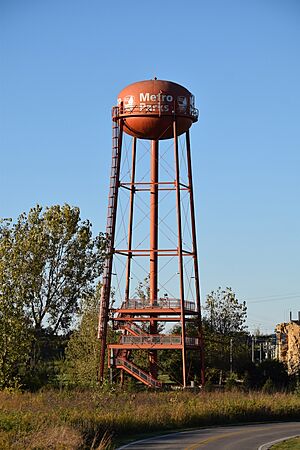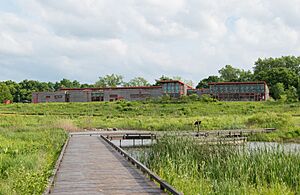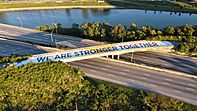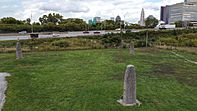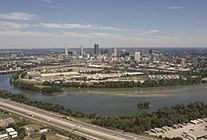Scioto Audubon Metro Park facts for kids
Quick facts for kids Scioto Audubon Metro Park |
|
|---|---|

Aerial view of the park amid Downtown Columbus
|
|
| Location | 400 W. Whittier St, Columbus, Ohio |
| Area | 120 acres (49 ha) |
| Owned by | City of Columbus |
| Administered by | Columbus and Franklin County Metro Parks |
| Visitors | about 800,000 annually |
| Parking | Multiple lots |
| Public transit access | |
Scioto Audubon Metro Park is a cool public park and nature preserve in Columbus, Ohio. It's managed by the Columbus and Franklin County Metro Parks. This park is also part of the Scioto Mile, a group of parks and trails around Downtown Columbus.
The park has lots of fun things to do. You can find trails, wetlands, and even a rock climbing wall. There are also courts for volleyball and bocce. A special place here is the Grange Insurance Audubon Center. It's unique because it's a nature center built right next to a big city downtown area!
This area used to be an industrial site, meaning it had factories and old buildings. It needed a lot of cleaning up before it could become a park. Planning for the park started in 2003, and it officially opened in 2009. It began as 94 acres and later grew to 120 acres.
Contents
What's Inside Scioto Audubon Park?
Scioto Audubon Metro Park is located on the Whittier Peninsula in Columbus. It's near the Brewery District and the Scioto River. You can easily walk to it from downtown Columbus in about 10 minutes. From the park, you get amazing views of the city skyline. The park was designed by MKSK, a company that creates urban spaces and landscapes. They also designed the larger Scioto Mile area.
Fun Features and Activities
The park has a main activity area with a tall climbing wall. There's also a water tower that has two platforms where you can look out over the park. You can play sand volleyball on one of the three courts.
Other cool spots include:
- A dog park that's about 2.5 acres big.
- An obstacle course with nine different challenges.
- Seven small wetlands, which are like mini-swamps, covering about 5 acres.
- Fields for recreation and a hill for sledding in winter.
- A butterfly garden, bocce courts, and a park office.
- A boat ramp and fishing docks for water fun.
The park also has restrooms, picnic tables, grills, and plenty of parking.
Trails for Exploring
The park has several trails for walking and running:
- The Hermit Thrush Trail is short, only 0.125 miles, and goes through a forest.
- The Columbus Rotary Running Track is 0.5 miles long.
- The Wetland Trail is 0.4 miles long.
- The longest trail is the Scioto Greenway Trail, which runs for about 2 miles through the park. This trail also connects to the Olentangy Trail, which is 14 miles long and goes all the way to Worthington.
The Giant Climbing Wall
The Metro Park climbing wall is 35 feet tall. It's made of fiberglass and has three towers and two arches. This 6,100 square foot structure is thought to be the biggest free outdoor climbing wall in the United States! Up to 20 climbers can use the wall at once. You can do different types of climbing here, like bouldering or using ropes. It's free to use, but you need to bring your own climbing gear.
Butterfly Garden
The butterfly garden was planted in 2016. It has seven raised areas and many different kinds of plants. These plants are chosen to attract about 40 different types of butterflies. They also bring in bees, wasps, and beetles. This garden is considered the largest butterfly garden in the entire Metro Parks system.
The park is open all year, but hours might change depending on the season. In 2014, over 800,000 people visited the park!
Grange Insurance Audubon Center
The Grange Insurance Audubon Center is located at the park's western edge. This 18,000 square foot building is special. It's the first Audubon center built so close to a city downtown. It opened in August 2009, costing $14.5 million to build. Audubon Ohio manages the center.
The center has classrooms, a library, and a large auditorium that seats 200 people. There are also demonstration gardens and a room for watching birds. The building was designed to be good for the environment. It uses natural light and has a green roof with native plants. It also uses geothermal heating and collects rainwater to filter it. The building has a high environmental rating called LEED Gold.
Important Bird Area
The Scioto Audubon Metro Park is part of the Scioto River-Greenlawn Important Bird Area. This is a three-mile long area along the river in the city. It also includes the 360-acre Green Lawn Cemetery and the Lou Berliner Sports Park. This area has seen more bird species than any other part of the Scioto River. Over 212 different kinds of birds have been recorded here!
Some of the birds you might see include:
- Northern pintail
- Pied-billed grebe
- American bittern
- Osprey
- Over ten types of gulls and terns
- Prothonotary warbler
- Northern waterthrush
- Peregrine falcons
- Bald eagles
- Cliff swallows
- Red-shouldered hawks
- Red-headed woodpeckers
- Yellow-crowned night heron
Nearby Cool Spots
Next to the park is an old overpass that goes over Interstates 70 and 71. In 2020, a 400-foot mural was painted on it. It says "We are stronger together," which was a message about the coronavirus pandemic.
The park also borders the Furnace Street Substation. This is an electrical station that has three tall stone statues. They are 16 feet tall and look a bit like Stonehenge. These statues are called Needles of Stone or Pillars of Stone. They were put there in 1989 to make the substation more interesting. They are about 100 feet away from the park, behind a fence.
History of the Park
The entire Whittier Peninsula, where the park is now, used to be full of factories, train yards, and warehouses. It was an industrial area that needed a lot of work to clean up. In the early 2000s, Columbus wanted to improve its riverfront, just like many other cities were doing. People suggested building ballparks or an amphitheater here.
However, conservation groups pushed for the area to become a park. Even back then, people were using the site for birdwatching. A three-mile area along the Scioto River still had its natural forest. It had also recently been named an Important Bird Area.
In 2003, the Columbus Metro Parks, the Columbus Recreation and Parks Department, and Audubon Ohio agreed to create the park. The city had to remove old buildings and underground storage tanks. They also had to clean up the soil from lead and arsenic. The park officially opened on August 28, 2009. It cost $14 million, with $11 million used to buy the land and clean up the pollution. The park's obstacle course was added in 2013.
Images for kids


